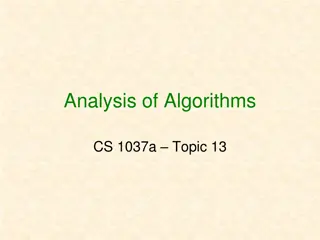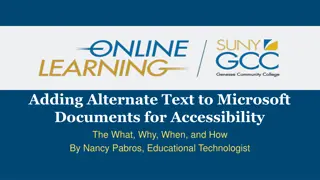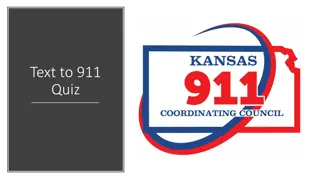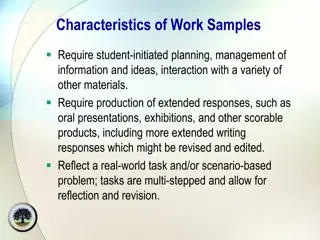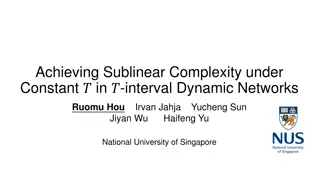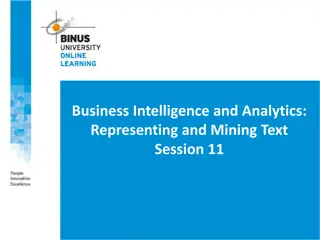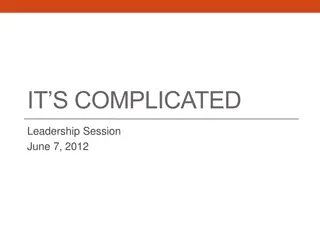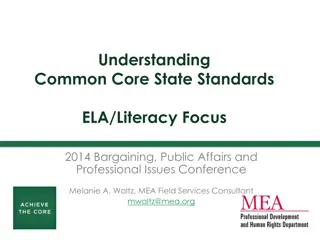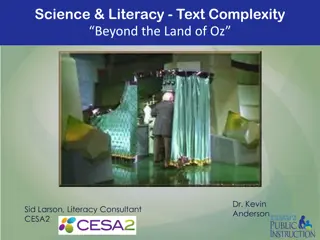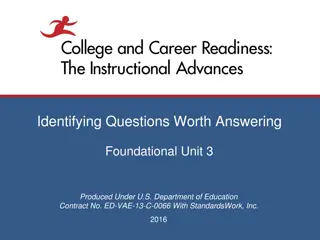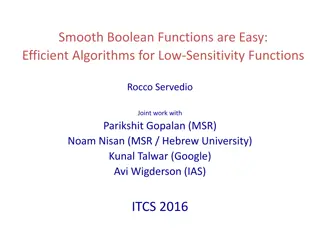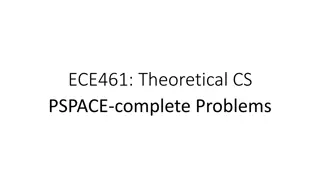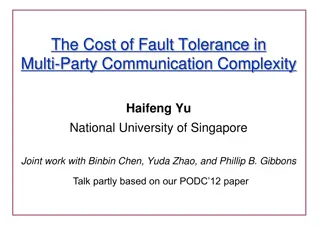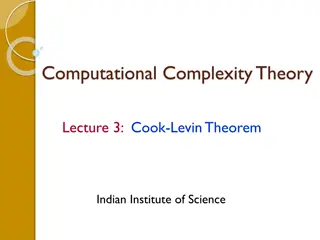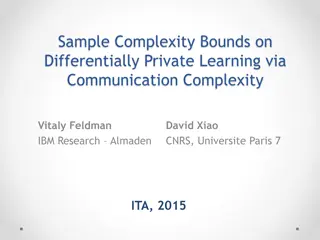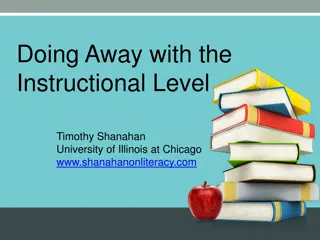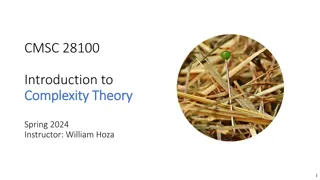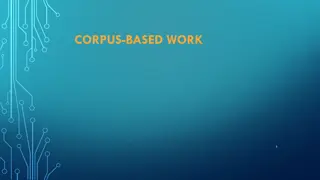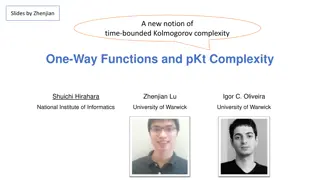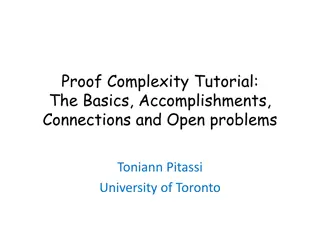Time Complexity in Algorithm Analysis
Explore the concept of time complexity in algorithm analysis, focusing on the efficiency of algorithms measured in terms of execution time and memory usage. Learn about different complexities such as constant time, linear, logarithmic, and exponential, as well as the importance of time complexity co
4 views • 73 slides
Enhancing Accessibility Through Alternate Text in Microsoft Documents
Explore the importance of alternate text in Microsoft documents for accessibility. Learn what alternate text is, why and when you should use it, and how to add it effectively. Discover the benefits of incorporating alternate text and the legal aspects related to accessibility under Section 508. Enha
0 views • 23 slides
Quantum Query Complexity Measures for Symmetric Functions
Explore the relationships between query complexity measures, including quantum query complexity, adversary bounds, and spectral sensitivity, in the context of symmetric functions. Analysis includes sensitivity graphs, the quantum query model, and approximate counting methods. Results cover spectral
1 views • 19 slides
Essential Information on Text-to-911 System
Explore key details about the text-to-911 system, including capturing text conversations, handling abandoned calls, transferring text calls to queues, and managing text conversations effectively. Learn about system configurations, call release timings, and dispatcher capabilities in handling text me
3 views • 12 slides
Developing Effective Reading Work Samples
Creating reading work samples involves steps like identifying a topic, analyzing passages, drafting tasks, formatting, administering, scoring, and revising tasks. Considerations include text complexity, high student interest, and grade-level appropriateness. Text complexity is assessed quantitativel
1 views • 15 slides
Achieving Sublinear Complexity in Dynamic Networks
This research explores achieving sublinear complexity under constant ? in dynamic networks with ?-interval updates. It covers aspects like network settings, communication models, fundamental problems considered, existing results, and challenges in reducing complexity. The focus is on count time comp
2 views • 14 slides
The Role of Text Complexity in Developing Conceptual Knowledge
Conceptual learning involves organizing new information into mental structures, focusing on big ideas and themes. While text complexity is often seen as a barrier to learning, it is essential for promoting high-level academic learning. Complex ideas require complex text that explains extensive infor
2 views • 74 slides
Text Representation and Mining in Business Intelligence and Analytics
Text representation and mining play a crucial role in Business Intelligence and Analytics. Dealing with text data, understanding why text is difficult, and the importance of text preprocessing are key aspects covered in this session. Learn about the goals of text representation, the concept of Bag o
2 views • 27 slides
Text Complexity and Reading Strategies in Education Sessions - June 7, 2012
Explore the engagement with text complexity and effective reading strategies in an educational workshop conducted on June 7, 2012. Delve into discussions on understanding text complexity levels, using margin notes and graphic organizers, and sharing key takeaways. Reflect on the challenges U.S. stud
6 views • 10 slides
Understanding Common Core State Standards ELA/Literacy Focus - Shifts and Text Complexity
The Common Core State Standards for ELA/Literacy require three key shifts, emphasizing regular practice with complex text and academic language, grounding reading, writing, and speaking in textual evidence, and building knowledge through content-rich nonfiction. The importance of practicing with com
5 views • 33 slides
Text Complexity in Science and Literacy Education
Exploring the concept of text complexity beyond the familiar realm of Oz, this presentation delves into quantitative and qualitative measures, reader and task considerations, and steps to assess text complexity. Various resources and examples are provided to help educators gauge and improve the comp
1 views • 43 slides
Holographic Complexity in Hybrid De Sitter Spacetime
The research delves into holographic complexity in a hybrid de Sitter spacetime, exploring the AdS/CFT correspondence, quantum information in the bulk, and computational complexity. It also examines the volume of the ERB, evolution of complexity in CFT, and probes cosmological horizons using hologra
4 views • 12 slides
Enhancing Reading Comprehension Through Text-Dependent Questions
This resource delves into the significance of text-dependent questions in improving students' reading comprehension skills by emphasizing the importance of evidence from the text, building knowledge through nonfiction, and developing critical thinking abilities. It highlights key advances in educati
4 views • 16 slides
Complexity Measures of Boolean Functions
This work delves into the intricate world of complexity measures for Boolean functions, exploring concepts such as certificate complexity, decision tree depth, sensitivity, block sensitivity, PRAM complexity, and more. It sheds light on the relationships among different complexity measures and provi
3 views • 36 slides
Interactive Proofs in Complexity Theory
Delve into the realm of interactive proofs in complexity theory, exploring concepts such as completeness, soundness, and efficiency. Discover how interactive proof systems can be utilized in scenarios like graph isomorphism and their implications on the complexity classes NP and coNP. Uncover the in
1 views • 40 slides
PSPACE-Complete Problems in Complexity Theory
This content delves into complexity theory, exploring PSPACE-complete problems and their relevance within the realm of theoretical computer science. It covers concepts such as time complexity classes, P vs. NP dilemma, NP-complete languages, space complexity, PSPACE vs. NPSPACE, and PSPACE completen
3 views • 19 slides
Powerful Text Features in Illustrator
Illustrator offers a range of powerful text tools, including point type, area type, and type on a path. These tools allow you to add text to your artwork in various ways, such as creating headlines, paragraphs, or flowing text along shapes or paths. You can control text flow, wrapping, and alignment
4 views • 12 slides
The Cost of Fault Tolerance in Multi-Party Communication Complexity
This work delves into the intricate realm of multi-party communication complexity, examining the minimum communication required for fault-tolerant computations. The study explores how various functions cope with failures, presenting insights on the exponential complexity blowup needed to withstand f
3 views • 35 slides
Unlocking Common Core State Standards Insights
Go beyond the surface with this jigsaw activity by the Illinois State Board of Education English Language Arts specialists. Delve into key implementation ideas, text complexity, writing types, and characteristics of a college-ready student. Explore key considerations, prioritizing text complexity, w
2 views • 14 slides
Complexity Theory Lecture 3: Cook-Levin Theorem Overview
Dive into Complexity Theory with Lecture 3 covering the Cook-Levin Theorem, NP complexity classes, NP-completeness, and a natural NP-complete problem. Explore proofs and key concepts in computational complexity.
2 views • 48 slides
Sample Complexity Bounds on Differentially Private Learning via Communication Complexity
This study explores sample complexity bounds on differentially private learning through communication complexity. It delves into the intersection of PAC learning model, privacy, and more, providing insights on the cost of privacy and related results in the field.
3 views • 14 slides
Text Complexity and Academic Language in Grades 6-12
Explore the Connecticut Core Standards for English Language Arts and Literacy, focusing on instructional shifts and the importance of engaging with complex academic texts. The progression of text complexity, from elementary to high school levels, is crucial for developing students' academic vocabula
0 views • 15 slides
Rethinking Reading Instruction: Moving Beyond Text Levels
Explore the reasons behind the shift to text complexity in reading instruction, highlighting the ineffectiveness of using below-grade-level texts and the importance of reconceptualizing reading as making sense of ideas, rather than answering questions. Learn about common classroom responses to text
2 views • 79 slides
Complexity Theory and Extended Church-Turing Thesis
Explore the robustness of complexity class P, the Extended Church-Turing Thesis, challenges in randomized and quantum computation, and communication complexity in this introduction to Complexity Theory. Delve into the role of randomness in computing and the efficiency of communication channels in co
2 views • 22 slides
Insights into Information Complexity and Communication Theory
Delve into the realm of information complexity, classical information theory, and communication complexity. Explore applications in circuit complexity, streaming algorithms, data structures, and distributed computing. Uncover advancements in communication complexity, lower bounds, and interactive co
3 views • 29 slides
Exploring Complexity Theory in Quantum Computing
Delve into the fascinating world of Quantum Complexity Theory with a focus on BQP, Shor's Algorithm, NP-completeness, and the complexity of factoring integers. Discover how Factor could be a likely counterexample to the extended Church-Turing thesis and learn about the coNP complexity class.
2 views • 34 slides
Text Representation and Mining for Business Intelligence and Analytics
Discover the challenges and strategies in representing and mining text data for business intelligence and analytics. Learn about text preprocessing, term frequency, IDF, and the Bag of Words approach. Understand why text data can be difficult to work with and the importance of proper text representa
1 views • 27 slides
Circuit Minimization in Complexity Theory
Dive into the new complexity landscape surrounding circuit minimization, exploring topics such as the Minimum Circuit Size Problem, Meta-Complexity, Theory of Learning, and basic facts about MCSP. Discover the connections to learning theory and the implications for computational complexity.
3 views • 59 slides
Complexity Classes in Circuit Complexity Theory
Dive into the intricate world of complexity classes such as P, NP, and PSPACE in the realm of Circuit Complexity Theory, exploring questions on the relationships between these classes and the unknowns that challenge our understanding of computational complexity.
2 views • 41 slides
Corpus-Based Work and Text Corpora Analysis with NLTK
Learn about corpus-based work, creating lexical resources, using NLTK corpora, and analyzing text corpora. Explore the use of NLTK in accessing and analyzing various text corpora, including the Gutenberg Corpus and web/chat text. Discover how NLTK allows for the analysis of linguistic annotations in
5 views • 21 slides
Time-Bounded Kolmogorov Complexity and One-Way Functions
Explore the concept of time-bounded Kolmogorov complexity, one-way functions, and their relevance in complexity theory and cryptography. Understand the definitions, properties, and significance of one-way functions in various cryptographic applications like private-key encryption and digital signatu
2 views • 32 slides
Unveiling Proof Complexity: Basics, Connections, and Open Problems
Delve into the world of proof complexity with a tutorial covering propositional, algebraic, and semi-algebraic proof systems, fundamental connections to complexity theory, algorithmic implications, and open problems. Explore resolution, restricted forms, and the Proof Complexity Zoo along with algor
2 views • 76 slides
Computational Complexity and Fixpoint Logics Relationship
Delve into the intricate connection between computational complexity and fixpoint logics as explored in the seminal work by Abiteboul, Vardi, and Vianu. From overcoming fundamental mismatches to defining relational complexity classes, this research sheds light on the interplay between logic and comp
1 views • 12 slides
Oracles in Complexity Theory: A Comprehensive Overview
Delve into the realm of Complexity Theory with this insightful exploration of oracles, complexity classes, proof techniques, and hierarchy theorems. Discover the core concepts and goals of Complexity Theory through a detailed examination of problem classification and relationships between classes. U
2 views • 24 slides
Final Exam Review and Complexity Classes
Covering a wide array of topics including decision-making, optimization, approximation, complexity classes, oracles, Kolmogorov complexity, circuit complexity, and more. Prepare thoroughly with in-depth insights and challenges in the field of computational theory. Get ready for your final exam with
3 views • 23 slides
Descriptive Complexity in Complexity Theory
Explore descriptive complexity and inexpressibly proofs in complexity theory, focusing on the connection between computational and descriptive complexity. Discover the intricacies of first-order logic, fixpoint logic, and second-order logic in capturing properties and formulating complex formulas. D
1 views • 37 slides
Text Processing with UNIX at Stanford University
This course adapted from "Unix for Poets" by Ken Church and facilitated by Dan Jurafsky and Chris Manning at Stanford University covers text processing using UNIX tools with a focus on modularity, simplicity, and efficiency. From counting words to analyzing text patterns and working with n-gram stat
3 views • 38 slides
Understanding Communication Complexity in Complexity Theory
Explore the fascinating world of communication complexity within complexity theory, covering topics such as randomized protocols, deterministic protocols, and the analysis of communication protocols for computational tasks like equality computation.
3 views • 24 slides
Introduction to Text Analysis with Anaconda and Virtual Environments
Explore the world of text analysis using tools like Anaconda and virtual environments. Learn about the importance of text analysis, creating virtual environments, the text analysis pipeline, and real-world examples like the American Community Survey. Discover the case for text analysis, feature extr
4 views • 25 slides
Complexity Theory Insights
Explore key concepts in complexity theory including sublinear-space computation, complexity classes like NL, surprises in NL complexity, Savitch's Theorem, Immerman-Szelepcs.nyis's Theorem, and proofs and algorithms related to space complexity.
2 views • 22 slides
